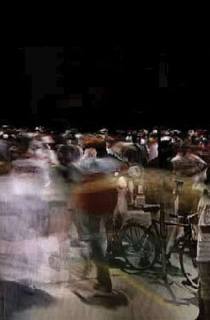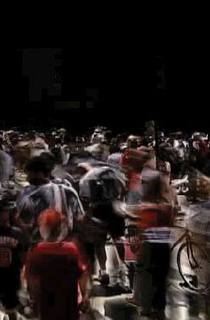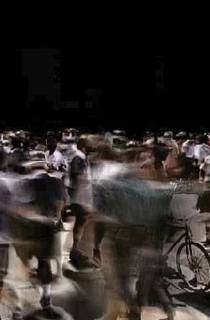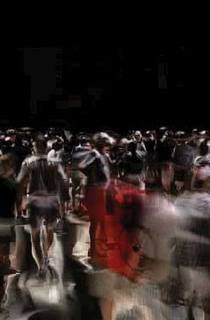i:move* Variations on a series
“… celebrates the personal and collective movements of each day by incorporating video stream processing, and live interaction to visualize dynamic patterns over a 24-hour cycle.”

Stills from high definition visual analysis of flow in time and space produced for cable television in Philadelphia.
The basic principle articulated by William H. Whyte’s early recordings of public spaces, still holds. Whyte observed that, in public urban spaces, “people looking at other people” is the primary activity – lovers enjoy “standing on the busiest corners”, friends have “travelling conversations” and people may simply talk to themselves.
Today’s advanced machine vision systems generate unparalleled quality, speed and graphic realism in the capture and analysis of dynamic visual data. By re-thinking the deployment of these technologies, Breyer aims to enable participants and viewers, in everyday public spaces, to observe the characteristics and routine cycles of pedestrian movement. These recorded and analyzed patterns of motion reveal dynamic histories of presence that are presented through live and prerecorded video layers.
i:move is a performance / installation series that explores how we perceive movement. The project celebrates the personal and collective movements of each day by incorporating video stream processing into live interaction to visualize dynamic patterns over a 24-hour cycle. The series has been developed for public spaces that are “bottle necks” of human traffic; including, the IM Pei archway at Massachusetts Institute of Technology (MIT) in Cambridge, Massachusetts where continuous motion trails occur like reliable, unpredictable weather patterns: skateboarders share the pathway with professors, students & tourists as they dance complex paths of avoidance and collision. i:move captures coincidences and irregularities of pedestrian behavior, transforming them into two-dimensional shadow plays, that emphasize repetitive rhythms and rituals of daily activities. The results are presented as interactive video projections, processed with text and live video layers presenting a dynamic visual etching of the ebb & flow of movement through public space.
i:move* is a stream processing system software that considers human movements over multiple time scales, perspectives, and magnifications to generate a concise, powerful, and efficient expression of time-oriented computing. Activity in the space is captured, processed and presented dynamically using video camera. Video layering gives a “time axis” for seeing the space as a visual record of motion. Video processing is used to enhance contrast, reveal coincidences. Interactive video is used to engage viewers in playful experimentation.
No comments yet. Why not add the first?
Acknowledgements & Credits
Acknowledgements
i:move was first presented by Nell Breyer with Kristin Ing at the Boston Cyberarts Festival in 2003. The i:move series software and video materials were further developed in collaboration with Jonathan Bachrach for the MIT Media Lab (2003) and with Fico Balet (Slovenia) for Dance Theater Workshop Gallery (2004). Additional collaborators include Aleksandar Zlateski (MIT).
Credits
Texts: All texts were written by the exhibition participants.
Editor: Pamela Jennings, Pittsburgh, PA (USA)
This work has been republished from the 2007 Exhibition 'Speculative Data and the Creative Imaginary: Shared Innovative Visions between Art and Technology' curated by Pamela Jennings As part of the ACM Creativity and Cognition Conference at at the National Academy of Sciences' headquarters at 2100 C St., N.W., Washington, D.C. The original exhibition catalogue can be found at: http://www.pamelajennings.org/PDF/NAS_Catalog.pdf
Exhibition Sponsors
Office of Exhibitions and Cultural Programs of the National Academy of Sciences presenting a program of exhibitions that explore relationships among the arts and sciences, engineering and medicine.
http://www7.nationalacademies.org/arts/
The 2007 Association for Computing Machinery Creativity and Cognition Conference held in Washington D.C. June 13th – 15th, 2007, exploring the theme of cultivating and sustaining creativity: understanding how to design and evaluate computational support tools, digital media, and socio-technical environments that not only empower our creative processes and abilities, but that also encourage and nurture creative mindsets and lifestyles. - http://www.cs.umd.edu/hcil/CC2007/
National Science Foundation Computer, Information Science and Engineering (CISE) Creative IT Program, exploring the synergies between creativity and information technology, science, engineering, and design research.
Copyright is held by the author/owner(s) of the text and images reproduced in this catalog.



← Back to work
0 Comments